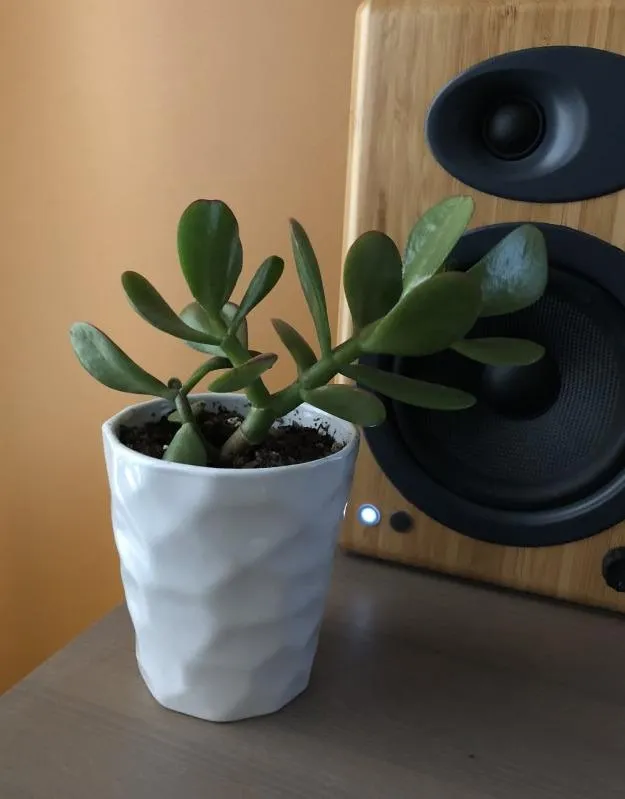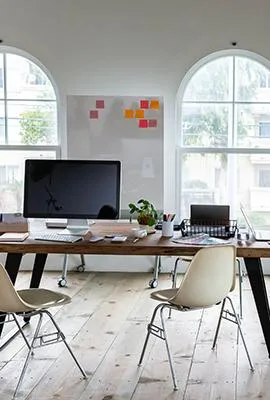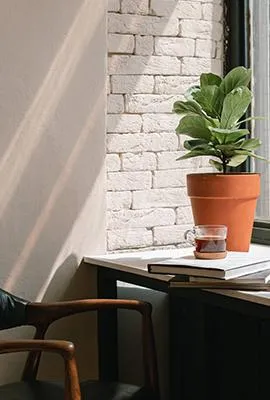Biophilic Design
The Key to Calm and Relaxing Atmosphere
Biophilia imitates nature indoors, promoting well-being and productivity by connecting us with nature while indoors.
What is Biophilia?
Biophilia is defined as a love of life and the living world. In Edward Wilson’s 1984 book, Biophilia, he called it the rich, natural pleasure that comes from being surrounded by living organisms.
As humans, most of us feel an innate draw to nature. Some of us express it as the nature-loving, hiking in the wilderness enthusiast and others find the simplicity of house plants. The idea behind biophilia is that we long for an increased connection to our natural environment.
In today’s fast-paced world, we spend so much time indoors, busily working along with our artificial light, that it has a tendency to affect us in ways we don’t always pay attention to. Poorly-made artificial lighting that weakens our eyes, indoor air quality issues and even the hums and buzzes of appliances can all affect our mood and well-being.

What is Biophilic Design?
Natural Design, also known as Biophilic or Organic Design, is a design that takes the love of living things and simply being alive and applies it to structures. It combines pleasing shapes and structures with proper lighting, temperature, airflow, and plant life to generate a sense of natural coexistence with the real world while in the comfort of an indoor space.

Why Biophilia?
Thousands of studies have shown the physical and mental health benefits of nature sounds as an ambiance for homes & businesses-natural ambiance has been shown to improve moods, increase focus, and promote relaxation at the same time. Regardless if you want a healthy mental focus at home or want to improve the state of your employees, biophilic audio is a perfect solution.
How Does Organic Design Work?
Plants do a lot more for a space than looking pleasing. One lesser known effect of plant-life in an indoor environment is that it can help control audio and acoustics. Studies show that placing plants strategically in a room diffuses and deflects sound, without the need for white noise machines.

A Plethora of Ideas
Combine Life and Nature
As WELL Accredited Professionals (Well AP credited) and Delos partners, we are committed to advancing human health and wellness.
By combining smart office and automation technologies with nature, we can create environments that bring you the opportunity to reconnect with your roots in nature. In addition, we can use customized technology in creative ways to bring life and vibrancy to your space.

Smart Lighting
Mimic natural light and vary based on time of day, style, and room purpose.

Indoor Air Quality
Purify the air, create gentle airflow, or even automate opening doors and windows.

Natural Audio
Soothing sounds of nature to help you relieve stress from those long, hard days.

Wellness Stimuli
From water features to automating pleasing smells, enhance your living.
Biophilic Design Dimensions
Increase Your Connectivity To Nature
Whether you realize it, we all have a physical longing for the sounds, smells, and sights of the great outdoors. The lighting and air conditions help keep our circadian rhythms in sync.
There are 3 Dimensions of Biophilic Design:
1. Direct Nature Experience
2. Indirect Nature Experience
3. Space and Place Experience
1. Direct Natural Experience
Visuals are one of the most important components of experiential install design. They can be used to create stunning and immersive environments that transport visitors to other worlds. For example, projection mapping can be used to create the illusion of walking through a rain forest or exploring a spaceship.
To create a truly immersive visual experience, experiential install designers use a variety of techniques, including:
Light: Proper lighting can allow a better connection with the time of day and season. Light helps with finding your way as well as mood alteration. It can also cause natural patterns, movement, and shadows to create an interesting effect.
Air: Through air and air movement systems, we feel ventilation, temperature, and humidity. While we often think of windows, doors, and traditional HVAC systems for this use, automating air movement and purification can create comfort.
Water: Water is multi-sensory. In design, it can be used to give movement, sound, touch, and sight experiences. It can be created in design with fountains, water features, aquariums, etc. Water is often used to decrease stress and increase health, and performance.
Plants: Bringing plant life to your exterior and interior provides that direct relationship and connection to nature. Plants have been proven to increase physical health, performance, and productivity and reduce stress.
Animals: While we often do not consider bringing livestock into our home or business, connection with animal life can be done through aquariums, flower beds, animal feeders, or green roofs.
Natural landscapes: By creating self-sustaining ecosystems built into your surroundings, you can enjoy landscapes that give you a feeling of spaciousness and natural life. Gardens, flower beds, or even Savannah-like areas can help you enjoy your space more.
Fire: When implemented correctly into your environment, fire provides color, warmth, and movement, all of which are appealing to the eye and pleasing to the senses.
2. Indirect Natural Experience
Visuals are one of the most important components of experiential install design. They can be used to create stunning and immersive environments that transport visitors to other worlds. For example, projection mapping can be used to create the illusion of walking through a rain forest or exploring a spaceship.
To create a truly immersive visual experience, experiential install designers use a variety of techniques, including:
Images of Nature: Whether it be paintings, photos, sculptures, murals, videos, or other images, images depicting nature have been proven to be pleasing. comforting, and calming.
Natural Materials: Natural materials can include things like wood, stone, or other materials found in nature. These materials tend to patina over time which can create very interesting variations.
Natural Colors: Natural colors are often referred to as “earth tones”. These are the colors that are commonly found in nature and are often subdued browns, greens, and blues.
Simulations of Natural Light and Air: When natural ventilation and light cannot be achieved, you can get creative with interior lighting and ventilation to mimic changes and flows in nature. This can be done through different types of lighting, reflective materials, and natural geometries. Natural airflow can be imitated through mild changes in temperature, humidity, and airflow.
Nature-like Shapes: Using an architectural design with columns or nature-based patterns on facades, for example, can give a boring space intrigue.
Natural Geometries: Fractals are one of those components that, when used in design, can create intrigue. Studies by MIT have also concluded that the ordered complexity of fractals in nature has the power to reduce stress.
Bio-mimicry: Bio-mimicry is a process that uses design to learn from and mimic the strategies used in nature for sustainable living. Though complex in thought, the most simple concept of bio mimicry is the invention of Velcro. In 1941, engineer George de Mestral was walking his dog when he noticed burrs sticking to both of them. When he studied the burrs under magnification he found their clinging property was the result of hundreds of tiny hooks. This gave thought to the invention of Velcro.
3. Space and Place Experience
The experience of space and place uses spatial relationships to enhance well-being:
Prospect and Refuge: Refuge refers to comfortable and nurturing interiors (alcoves, quiet areas, dimmer lighting), while prospect is more about horizons and movement. These can include spaces and effects like balconies, lighting changes, alcoves, and spacious areas.
Order and Complexity: Simulating controlled variability (Like fractals in nature), this is done in design through repetition, change, and detail to achieve an intriguing balance between boring and overwhelming.
Integration of Parts: This describes the process of connecting the individual parts of a space in order to provide a unified experience. When parts of the space are not integrated, it can become a fragmented, disconnected, and even uncomfortable environment.
Transitional Spaces: Transitional spaces connect interior spaces with the outside or create comfort by providing access from one space to another through the use of porches, decks, atrium's, doors, bridges, foyers, etc.
Mobility: Mobility is the ability to move comfortably between spaces. It provides a feeling of security and can be done by making clear entry and exit points.
Cultural and Ecological Attachment to Place: By incorporating the area’s geography and history into a space, you can create a feeling of cultural connection and identity. Ecological attachment is done through the creation of ecosystems that promote the use of native plants and animals.
Want To Know More About Biophilic Design For Your Home?
Get In Touch Today.

Quick Links
Sphere Audio Video | © 2025. All Rights Reserved
Site By Trustway Marketing
Powered by Kyrios Systems